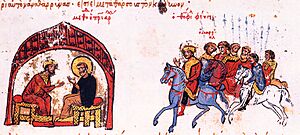Methodios I of Constantinople facts for kids
Quick facts for kids SaintMethodius I |
|
|---|---|

Late 14th-early 15th century icon illustrating the "Triumph of Orthodoxy" in 843. Methodius is depicted in the upper register, to the right of the icon, with Theodora and her son Michael to the left. (National Icon Collection 18, British Museum)
|
|
| Patriarch of Constantinople Hegumen |
|
| Born | 788 Syracuse, Theme of Sicily (modern-day Italy) |
| Died | 847 Constantinople, Byzantine Empire (modern-day Istanbul, Turkey) |
| Venerated in | Eastern Orthodox Church Roman Catholic Church |
| Feast | June 14 |
| Ecumenical Patriarch of Constantinople | |
| Enthroned | 843 |
| Reign ended | 847 |
| Predecessor | John VII |
| Successor | St Ignatius |
| Personal details | |
| Denomination | Chalcedonian Christianity |
Saint Methodius I (also known as Methodios I) was an important leader in the Christian church. He was the Ecumenical Patriarch of Constantinople from 843 to 847. This means he was the head of the church in Constantinople, a very big city in the Byzantine Empire. Methodius was born in Syracuse around 788 and passed away in Constantinople on June 14, 847. People remember him and celebrate his feast day every year on June 14.
Contents
Early Life and Becoming a Monk
Methodius was born into a rich family in Syracuse, a city in Sicily. When he was a young man, his parents sent him to Constantinople. They hoped he would get a good education and find a job working for the emperor.
But Methodius had other plans. Instead of working at court, he decided to join a monastery in a place called Bithynia. A monastery is a place where monks live and dedicate their lives to religious study and prayer. Methodius worked hard and eventually became the abbot, which is the leader of the monastery.
Standing Up for Icons
During this time, there was a big disagreement in the Byzantine Empire called Iconoclasm. This was a period when some people believed that religious images, called icons, should not be used or honored. They thought it was wrong to have them in churches. Others, like Methodius, believed that icons were important for worship and should be respected. These people were called iconodules.
In 815, a new emperor named Leo V started a second wave of iconoclast persecution. This meant that people who supported icons were arrested and punished. Methodius traveled to Rome, perhaps to deliver a message from the patriarch (church leader) who had been removed from his position.
When Methodius returned in 821, he was arrested. The new emperor, Michael II, was strongly against icons. Methodius was sent away because he believed in using icons.
Return to Power and the End of Iconoclasm
Methodius was released in 829. He then gained an important role at the court of Emperor Theophilos. Even though Theophilos was also against icons, Methodius managed to stay safe.
After Emperor Theophilos died in 843, his wife, Empress Theodora, became the regent for their young son, Michael III. A powerful minister named Theoktistos convinced Empress Theodora to allow icons back into the churches. They made sure that her dead husband, the emperor, would not be officially condemned for his views against icons.
The iconoclast patriarch, John VII Grammatikos, was removed. Methodius was then chosen to become the new Patriarch of Constantinople. This important event marked the end of the long and difficult iconoclast controversy.
The Triumph of Orthodoxy
A week after becoming patriarch, Methodius led a special procession. On March 11, 843, he walked from the Church of Blachernae to the famous Hagia Sophia church. Empress Theodora, her son Michael, and Theoktistos joined him. During this procession, they brought the icons back into the church.
This event was a huge moment for the church. It showed that the traditional beliefs about icons were restored. This day became a special holiday in the Byzantine Church. It is celebrated every year on the First Sunday of Great Lent and is known as the "Triumph of Orthodoxy". It means the victory of the true Christian faith.
Challenges as Patriarch
During his time as patriarch, Methodius tried to be fair to everyone. He wanted to find a way for church leaders who had once been against icons to be accepted back into the church.
However, some very strict monks, especially from the Stoudios monastery, disagreed with this. They believed that those who had been iconoclasts should be severely punished. To keep things peaceful, Methodius had to take action. He even had to remove some of the most stubborn monks from the church and arrest them.
Methodius's Writings
Methodius was a very smart and well-educated person. He spent time copying important manuscripts and also wrote many of his own works. His writings included:
- Polemica: These were writings that argued against certain beliefs.
- Hagiographical works: These were stories about the lives of saints.
- Liturgical works: These were texts used in church services.
- Sermons: These were speeches given in church.
- Poetry: He also wrote poems.
See also
- Council of Constantinople (843)
- Theodora (wife of Theophilos)


